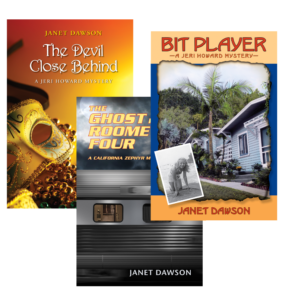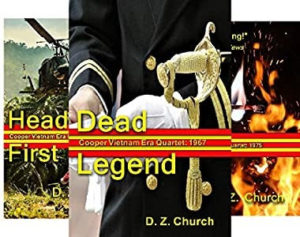Are We on First? Or Third? Janet Dawson wants to know!
One of the first decisions I make when I start writing a book is point of view. Will “I” be telling the story? Or will it be “she” or “he” providing the narrative? But hey, I can change my mind. And have, many times.
Writing in first person can provide both intimacy and immediacy. The reader is inside the head of the narrator—such as Jeri Howard, my private eye protagonist—discovering the plot and the characters as Jeri encounters both.
When I began writing Kindred Crimes, the first of the Jeri Howard books, it was clear that Jeri would tell her stories in first person. I was writing about a private eye, and many of the PI novels that influenced me, such as the Lew Archer novels by Ross Macdonald and the Sharon McCone novels by Marsha Muller, were written in first person. Maybe it’s a PI thing. like the classic PI case that starts in the detective’s office.

That’s what happens in the first chapter of Jeri’s most recent case, The Devil Close Behind.
It started with a phone call, as such things frequently do.
I was in my office on a quiet afternoon in April. The PI business had been slow. I’d finished up a couple of big cases and a handful of small ones. Now I was drinking my way through a fresh pot of coffee as I caught up on paperwork and filing.
When the phone rang, I peered over the rim of my coffee mug at the caller ID readout. A new client? Or an existing one?
No. My father was on the other end of the line.
Writing in third person may offer objectivity and omniscience, but not always. There are all sorts of third-person flavors. Limited to one character? Two? A handful? Or what is often called omniscient, where the reader gets inside the heads of many characters.
When I began writing the California Zephyr books, featuring Zephyrette Jill McLeod, I knew I would tell the stories in third person. The novels are set in the early 1950s, nearly 70 years ago. For me, writing about the past in third person puts some distance between me, the reader, and the events of the book. But not always. More about that later.
Jill’s stories unfold in the limited third person, so Jill’s POV is the only one the reader sees.
Here’s what Jill sees in the first chapter of The Ghost in Roomette Four.
I am not seeing this, Jill McLeod told herself. But she was.
Light shimmered at eye level, about ten feet in front of her. The apparition seemed to have no source. None, anyway, that Jill could discern. What’s more, she could see through it.

What You Wish For, my standalone suspense novel, is told from several viewpoints, in the present and past. The book has a large cast. But I didn’t want to confuse readers with too many POVs. Most of the novel comes from the viewpoint of Lindsay Page, a retired college professor. The other POVs are those of her friend Annabel, someone Lindsay shared a house with while she was in grad school in Berkeley in the 1970s. There’s also Flor, who fled the civil war in El Salvador. The fourth narrator is Rod Llewellyn, whose life intersects with all three women.
At times, I’ve used both first and third person in the Jeri Howard books. In Bit Player, Jeri investigates something that happened to her grandmother, Jerusha, who was a bit player, an actress who plays small roles, working in Hollywood in the early 1940s. When someone implies that Jerusha was involved in the unsolved murder of an actor, Jeri investigates. I wanted readers to see what happened in Hollywood from Jerusha’s POV, so I wrote those chapters in third person, putting some distance between Jeri’s case in the present and Jerusha’s life in the past. Jeri is time traveling via letters written by Jerusha to her sister. Jeri reading the letters provides the perfect segue to the 1940s.
Here’s an example from Bit Player.
End of Chapter 10:
I started where I’d left off, in the fall of 1941, and soon learned why my grandmother and the other housemates parted company with Sylvia Jasper.
Beginning of Chapter 11:
Los Angeles, California, October 1941
“I want her out!” Anne sputtered, indignation written on her face. “This is absolutely the last straw. I did not expect to come home tonight and find a naked man wrapped in a towel, eating cake here in the kitchen. What’s more, it was my towel.”
“It was my cake. The one I baked to take to a birthday party,” Jerusha added.
Now, about changing my mind. When I started The Sacrificial Daughter, my forthcoming novel featuring geriatric care manager Kay Dexter, I wrote the first few chapters in the first person. Then I switched to third person. Global search and replace time. I was several chapters farther along when I decided to switch back to first person. This can cause some POV minefields. Good thing I read the manuscript over and over and over. I miss places where I should change “my” to “her.”
Remember what I said earlier about third person providing some distance from events when writing about the past? Well, not always.
I’ve started a historical novel called Bloody Lincoln. It’s about Billy the Kid and the Lincoln County War, subjects that have fascinated me for decades. It took me a long time to figure out who would narrate that story—Catriona MacNeill, the daughter of an Army officer in the 1870s. She narrates the plot in the first person, as though writing in her journal. Which is logical, since she wants to be a writer, telling stories of her life on the frontier.
When it comes to point of view, there are always exceptions to the rule. That’s what makes writing fun.
I, She, He, Them … First- or Third-Person? D. Z. Church Ponders.
One would think that the minute a writer starts a book, they know what person they will be writing in … one would think?
In general, I do. But I swear, somewhere about a third of the way through every first-person book I’ve written, I’ve wondered if I made the correct choice. I think it is the itch to have the nemesis tell their own story that makes the third-person sound like a good idea about then. Maybe because I’ve become attached to the villain and want to give that person a voice. As a result, I’ve written whole scenes that are never used, trying to force a book into third-person from first- and sometimes vice versa.
Yikes, when a character demands their own voice!
“Need me to strap that on? I have some field experience.” Beneath the black horn-rims, his eyes, noir, schwarz, beltza, svart, black in any language absorbed the light in the room. He kneeled next to me, took my ankle in his hands, checked it over, then strapped on the brace. “Boo, they call you Boo, right? Relax. I’m not here to hurt you.” His silky baritone belied his claim.
With my newest standalone thriller, Booth Island, I had a fierce itch to share the nemesis’ point-of-view. So, I wrote his story in third-person and dropped it into the protagonist’s first-person text, flipping between the two points-of-view. I loved it, but it wasn’t the same book. A villain isn’t nearly as villainous when you know their side of the story, particularly this one, though it can be done effectively. And I did like the juxtaposition of the first- and third-person accounts. Maybe another time. In the end, I wove revelations about the nemesis developed in the third-person narrative into the protagonist’s story, the pacing benefitting from my noodling.
When the story is told from multiple points-of-view with converging action.
Byron squeezed Laury’s shoulders. “Relax. I’ll be careful. You promise me you’ll get past this. You’ve got three great girls, a herd of people who love you and depend on you. You’ve got the world. Me—I may have one more chance.”
Laury picked up the duffle bag. “Don’t use the word chance.”
Byron shook both of Laury’s shoulders from the stair above. “No wonder Mac loved you best. We needed you, the two of us.” Byron plucked his hat from the stairs where it rested on his briefcase, put it on his head, and squared the eagle insignia to the line of his nose.
“Yeah, well, we all know how well that turned out, one dead, one disgraced.”

The Cooper Quartet books tell the saga of a military/farming family. I have multiple storytellers, multiple locations, and multiple plots in each book. The books (Dead Legend, Head First, Pay Back, and next Don’t Tell) take place in Vietnam (or Hawaii), in Michigan (on the family farm), and in California (at Naval stations). The interweaving plots, locations, and merging action cried out for third-person. As I wrote each character’s section, the narrative was driven by that character’s emotions and needs so that a reader might easily substitute first-person pronouns and feel closer to the character. I hope I achieved this.
When the reader needs to share the protagonist’s trials and discoveries
I kneeled to wipe wet grass from the lawnmower blades keeping one eye on the men speaking to my neighbor. She pointed towards me. They waded across the lawn leaving perfect footprints in my freshly mown grass. White shirts, black ties, polished shoes, one suit coat button buttoned, they looked like the very cliché of FBI agents.
I slapped at a red ant harvesting on my bare ankle. As I scratched, a nondescript gray sedan parked at the curb in front of my neighbor’s house. Two men, one white, one black, both in gray suits, climbed out of the car. They walked in step up my neighbor’s driveway, looking not in the least interested in her assortment of junk.
My standalone thriller, Perfidia, is in the first person. Why? I wanted the heroine to live in a perpetual haze of surprise as she gathered her pluck and attacked each obstacle in her way. And as a plus, her voice helped me imagine my way through the perils she faced. It worked well.
As in Perfidia, first-person is handy in the reveal and pacing of a thriller, mystery, or suspense novel. Since the protagonist can’t know what is happening behind the scenes, the first-person provides moments of discovery, an unknown detail, some juicy tidbit that leads to a hunt or a body or a … that twists, turns, and barrels the tale to the climax.

When two protagonists demand attention!
Grieg glanced at Moms. He couldn’t breathe, half exhaustion, half stress, half Calypso Swale. Oops, that was 150 percent of something or fifty-percent of nothing. He gulped air, put his hands on his knees, and lost the battle to his memories. He was struggling to climb out the driver’s side door, the front-end of the Lexus LX SUV he’d stolen embedded in a black Cadillac XTS sedan, his windshield smashed, glass everywhere, including embedded in his hands.
A second standalone thriller, Saving Calypso started out in first-person but didn’t work and didn’t work in a big way because it is the story of two protagonists at odds with each other, each with their own nemeses. Only one way to tell that story…third-person. Not third-person omniscient, but just, good old-fashioned third-person with each narrator knowing only their side of the doings and emotions. In Saving Calypso, Grieg Washburn doesn’t know where or what is going on with Calypso Swale and vice versa. Grieg searches for Calypso as Calypso hides from him off-the-grid in the Sierra until their personal voyages merge. The two voices in Saving Calypso provided yards of fabric to stitch into the tale.
If I had to drop a word of wisdom, I’d say this: Let the genre, the plot and the players pick their voice.
As this eventful year draws to a close, grab a good book. A mystery or thriller, of course! Settle down with a cup of your favorite, be it coffee, tea, hot cider, eggnog, or something with more of a kick.
Happy Holidays to all of you from Janet and D.Z.
